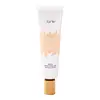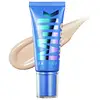What's inside
What's inside
 Key Ingredients
Key Ingredients

 Benefits
Benefits

 Concerns
Concerns

 Ingredients Side-by-side
Ingredients Side-by-side

Cyclopentasiloxane
EmollientIsododecane
EmollientMica
Cosmetic ColorantPolysilicone-11
Polymethylsilsesquioxane
Zinc Oxide
Cosmetic ColorantHexyl Laurate
EmollientPolyglyceryl-4 Isostearate
EmulsifyingCetyl PEG/PPG-10/1 Dimethicone
EmulsifyingAlumina
AbrasiveDiamond Powder
AbrasiveDipalmitoyl Hydroxyproline
Skin ConditioningPEG-10 Dimethicone
Skin ConditioningStearic Acid
CleansingTriethoxycaprylylsilane
CI 77891
Cosmetic ColorantIron Oxides
Cyclopentasiloxane, Isododecane, Mica, Polysilicone-11, Polymethylsilsesquioxane, Zinc Oxide, Hexyl Laurate, Polyglyceryl-4 Isostearate, Cetyl PEG/PPG-10/1 Dimethicone, Alumina, Diamond Powder, Dipalmitoyl Hydroxyproline, PEG-10 Dimethicone, Stearic Acid, Triethoxycaprylylsilane, CI 77891, Iron Oxides
Water
Skin ConditioningIsononyl Isononanoate
EmollientPropanediol
SolventIsostearyl Neopentanoate
EmollientGlycerin
HumectantOctyldodecyl Stearoyl Stearate
EmollientPolyglyceryl-2 Dipolyhydroxystearate
Skin ConditioningSaccharomyces/Xylinum/Black Tea Ferment
Skin ConditioningHydrogenated Ethylhexyl Olivate
EmollientCoco-Caprylate/Caprate
EmollientDicaprylyl Ether
EmollientPolyglyceryl-6 Polyricinoleate
EmulsifyingSqualane
EmollientPolyglyceryl-3 Diisostearate
EmulsifyingDimer Dilinoleyl Dimer Dilinoleate
EmollientPullulan
Niacinamide
SmoothingSodium Hyaluronate
HumectantCannabis Sativa Seed Oil
EmollientAgave Tequilana Leaf Extract
AstringentButyrospermum Parkii Butter
Skin ConditioningHelianthus Annuus Seed Oil
EmollientHydrogenated Olive Oil Unsaponifiables
EmollientTocopherol
AntioxidantPentaerythrityl Tetra-Di-T-Butyl Hydroxyhydrocinnamate
AntioxidantLecithin
EmollientDipalmitoyl Hydroxyproline
Skin ConditioningMagnesium Sulfate
Disteardimonium Hectorite
StabilisingPropylene Carbonate
SolventHydrogenated Styrene/Methylstyrene/Indene Copolymer
Lauroyl Lysine
Skin ConditioningStearic Acid
CleansingZinc Stearate
Cosmetic ColorantAllantoin
Skin ConditioningDistarch Phosphate
AbsorbentPalmitic Acid
EmollientMaltose
MaskingPotassium Sorbate
PreservativeSodium Dehydroacetate
PreservativeSodium Benzoate
MaskingPhenoxyethanol
PreservativeCI 77891
Cosmetic ColorantCI 77491
Cosmetic ColorantCI 77492
Cosmetic ColorantCI 77499
Cosmetic ColorantWater, Isononyl Isononanoate, Propanediol, Isostearyl Neopentanoate, Glycerin, Octyldodecyl Stearoyl Stearate, Polyglyceryl-2 Dipolyhydroxystearate, Saccharomyces/Xylinum/Black Tea Ferment, Hydrogenated Ethylhexyl Olivate, Coco-Caprylate/Caprate, Dicaprylyl Ether, Polyglyceryl-6 Polyricinoleate, Squalane, Polyglyceryl-3 Diisostearate, Dimer Dilinoleyl Dimer Dilinoleate, Pullulan, Niacinamide, Sodium Hyaluronate, Cannabis Sativa Seed Oil, Agave Tequilana Leaf Extract, Butyrospermum Parkii Butter, Helianthus Annuus Seed Oil, Hydrogenated Olive Oil Unsaponifiables, Tocopherol, Pentaerythrityl Tetra-Di-T-Butyl Hydroxyhydrocinnamate, Lecithin, Dipalmitoyl Hydroxyproline, Magnesium Sulfate, Disteardimonium Hectorite, Propylene Carbonate, Hydrogenated Styrene/Methylstyrene/Indene Copolymer, Lauroyl Lysine, Stearic Acid, Zinc Stearate, Allantoin, Distarch Phosphate, Palmitic Acid, Maltose, Potassium Sorbate, Sodium Dehydroacetate, Sodium Benzoate, Phenoxyethanol, CI 77891, CI 77491, CI 77492, CI 77499
 Reviews
Reviews

Ingredients Explained
These ingredients are found in both products.
Ingredients higher up in an ingredient list are typically present in a larger amount.
Ci 77891 is a white pigment from Titanium dioxide. It is naturally found in minerals such as rutile and ilmenite.
It's main function is to add a white color to cosmetics. It can also be mixed with other colors to create different shades.
Ci 77891 is commonly found in sunscreens due to its ability to block UV rays.
Learn more about CI 77891Dipalmitoyl Hydroxyproline isn't fungal acne safe.
Stearic Acid is a fatty acid. It is an emollient, emulsifier, and texture enhancer.
As an emollient, stearic acid helps soften skin. It aids the skin's protective barrier by preventing water loss. It also provides a gentle cleansing effect without stripping away natural oils.
Stearic acid may also be used to enhance the texture of products. It can add volume and stabilize ingredients such as water and oil. This can help water and oil ingredients from separating.
Sources of stearic acid include animal or vegetable fats/oils such as coconut or shea. It can be naturally found in butter, cocoa butter, shea butter, vegetable fats, and animal tallow.
This ingredient may not be Malassezia folliculitis, or fungal-acne safe.
Learn more about Stearic Acid